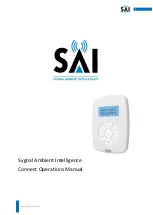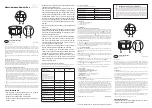
www.elt.es
30
8. INSTALLATION
8.1. General observations
The constant current power supply drivers for LED modules use sensitive electronic components. They have to be
handled and manipulated with care, as with any other electronic equipment.
The installation, maintenance and replacement of the drivers must be carried out by qualified personnel, strictly
in line with the given instructions for the product and current regulations, in order to achieve the correct level of
durability and operation for both the driver and the LED module it supplies.
To guarantee protection against electric shocks during any intervention involving the driver, the power supply must
be disconnected
8.2. Installation in luminaires
The eSMART control gear, classified as “build-to-use” drivers, must be installed inside the luminaire or in other
housings that guarantee protection from environmental conditions such as humidity, water, snow, ice and dust. ELT
recommends the use of luminaires with a minimum protection rating of IP54, however depending on the application,
higher protection levels may be necessary.
The luminaires, as well as the entire street lighting system, must provide adequate protection against electric shocks.
The eSMART control gear is categorised as equipment with “double and reinforced” insulation and is suitable for
installation in both Class I and Class II luminaires.
Insofar as it is possible, they must be installed away from heat sources and be fitted to maximise heat dissipation.
8.3. Connecting the drivers
To ensure that the eSMART drivers are correctly connected and work properly, the following instructions must be
taken into account:
▪
Do not exceed the permitted ranges for the electrical input and output values for the different connection terminals
of the drivers.
▪
The polarity indicated on the labelling must be observed at all times.
▪
DC operation is only allowed for equipment that has been specifically designed for the purpose.
▪
In three-phase 400V installations, ensure that the neutral is always connected. If this connection is broken, the
400V could reach the equipment, with the consequent risk of a breakdown. During installation, the distribution of
loads between phases must be balanced out as much as possible.
▪
The stripped length and cable section indicated on the equipment labelling must be respected for each connection
terminal.
▪
The maximum length of the cabling of the input terminals is limited by the brownout that takes place in it, so
that it complies with current regulations and standards. As such, it depends on the cable sections used and the
current circulating through them, which is established by the number of devices connected. Specifically, where
DALI communication is used, it must never exceed 300 metres without using repeaters or signal amplifiers.














































